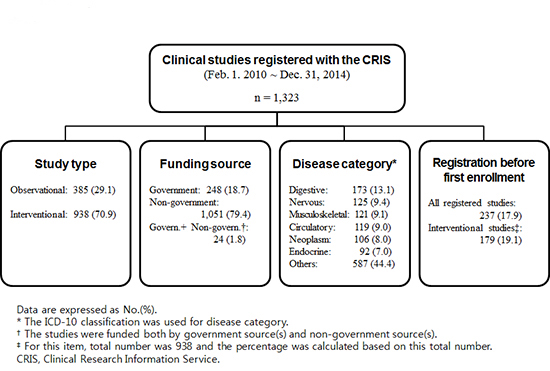1. Simes RJ. Publication bias: the case for an international registry of clinical trials. J Clin Oncol. 1986; 4:1529–1541.
2. Chan AW. Bias, spin, and misreporting: time for full access to trial protocols and results. PLoS Med. 2008; 5:e230.
3. Dickersin K, Min YI. Publication bias: the problem that won't go away. Ann N Y Acad Sci. 1993; 703:135–146.
4. Dickersin K, Rennie D. Registering clinical trials. JAMA. 2003; 290:516–523.
5. Viergever RF, Karam G, Reis A, Ghersi D. The quality of registration of clinical trials: still a problem. PLoS One. 2014; 9:e84727.
6. Park HY. Primary registry of the WHO International Clinical Trial Registry Platform: Clinical Research Information Service. J Korean Med Assoc. 2011; 54:92–97.
7. De Angelis C, Drazen JM, Frizelle FA, Haug C, Hoey J, Horton R, Kotzin S, Laine C, Marusic A, Overbeke AJ, et al. International Committee of Medical Journal Editors. Clinical trial registration: a statement from the International Committee of Medical Journal Editors. N Engl J Med. 2004; 351:1250–1251.
11. WHO. WHO International Clinical Trials Registry Platform. accessed on 19 March 2015. Available at
http://who.int/ictrp/en/.
13. Ministry of Health and Welfare, Korea Health Industry Development Institute. Condition and method for application, Grant announcement of health and medical technology R&D projects (stem cell and regenerative medicine). Cheongju: Korea Health Industry Development Institute;2015. p. 25.
22. Manchikanti L, Benyamin RM, Helm S 2nd, Hirsch JA. Evidence-based medicine, systematic reviews, and guidelines in interventional pain management: part 3: systematic reviews and meta-analyses of randomized trials. Pain Physician. 2009; 12:35–72.
23. Hudson KL, Collins FS. Sharing and reporting the results of clinical trials. JAMA. 2015; 313:355–356.
24. Alley AB, Seo JW, Hong ST. Reporting results of research involving human subjects: an ethical obligation. J Korean Med Sci. 2015; 30:673–675.
26. National Institute of Food and Drug Safety Evaluation. Survey on the awareness about clinical trial registration, Study on improvement of clinical trial registration and operation. Cheongju: National Institute of Food and Drug Safety Evaluation;2014. p. 62–63.
27. Viergever RF, Karam G, Reis A, Ghersi D. The quality of registration of clinical trials: still a problem. PLoS One. 2014; 9:e84727.
28. Reveiz L, Cortés-Jofré M, Asenjo Lobos C, Nicita G, Ciapponi A, Garcìa-Dieguez M, Tellez D, Delgado M, Solà I, Ospina E. Iberoamerican Cochrane Network. Influence of trial registration on reporting quality of randomized trials: study from highest ranked journals. J Clin Epidemiol. 2010; 63:1216–1222.
29. Killeen S, Sourallous P, Hunter IA, Hartley JE, Grady HL. Registration rates, adequacy of registration, and a comparison of registered and published primary outcomes in randomized controlled trials published in surgery journals. Ann Surg. 2014; 259:193–196.
30. Gandhi R, Jan M, Smith HN, Mahomed NN, Bhandari M. Comparison of published orthopaedic trauma trials following registration in Clinicaltrials.gov. BMC Musculoskelet Disord. 2011; 12:278.
31. Bourgeois FT, Murthy S, Mandl KD. Outcome reporting among drug trials registered in ClinicalTrials.gov. Ann Intern Med. 2010; 153:158–166.












 PDF
PDF ePub
ePub Citation
Citation Print
Print



 XML Download
XML Download